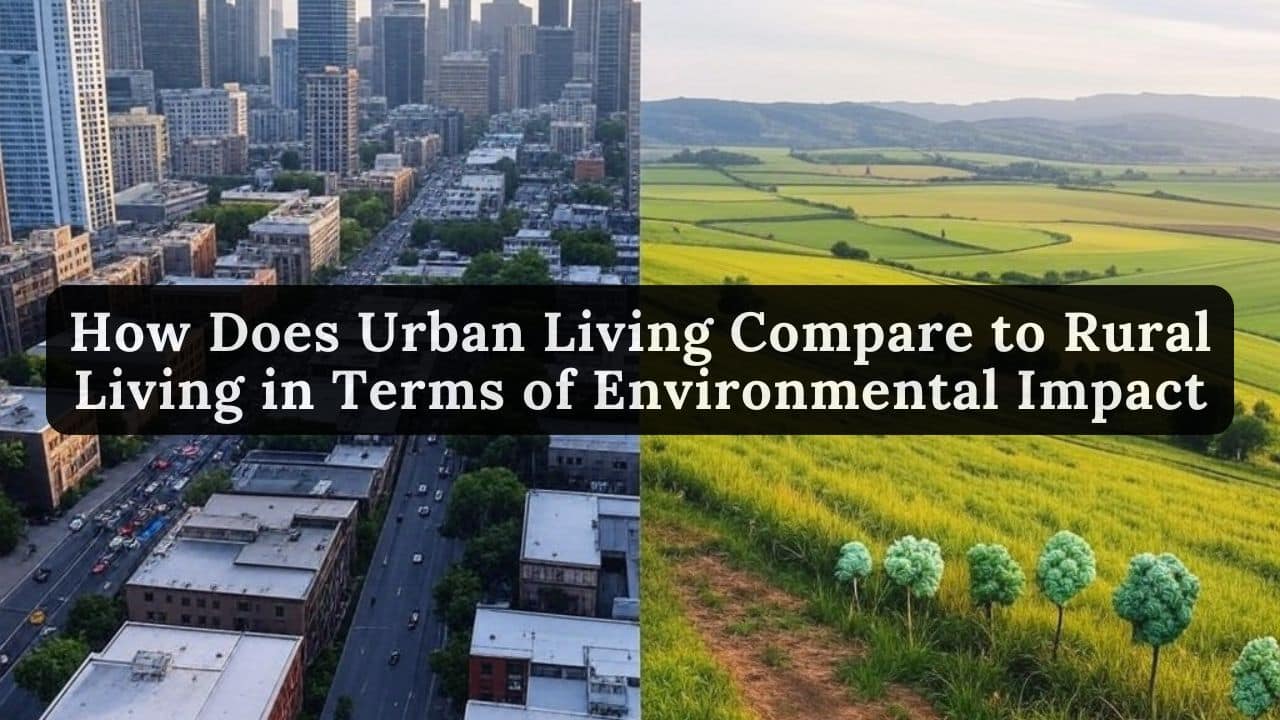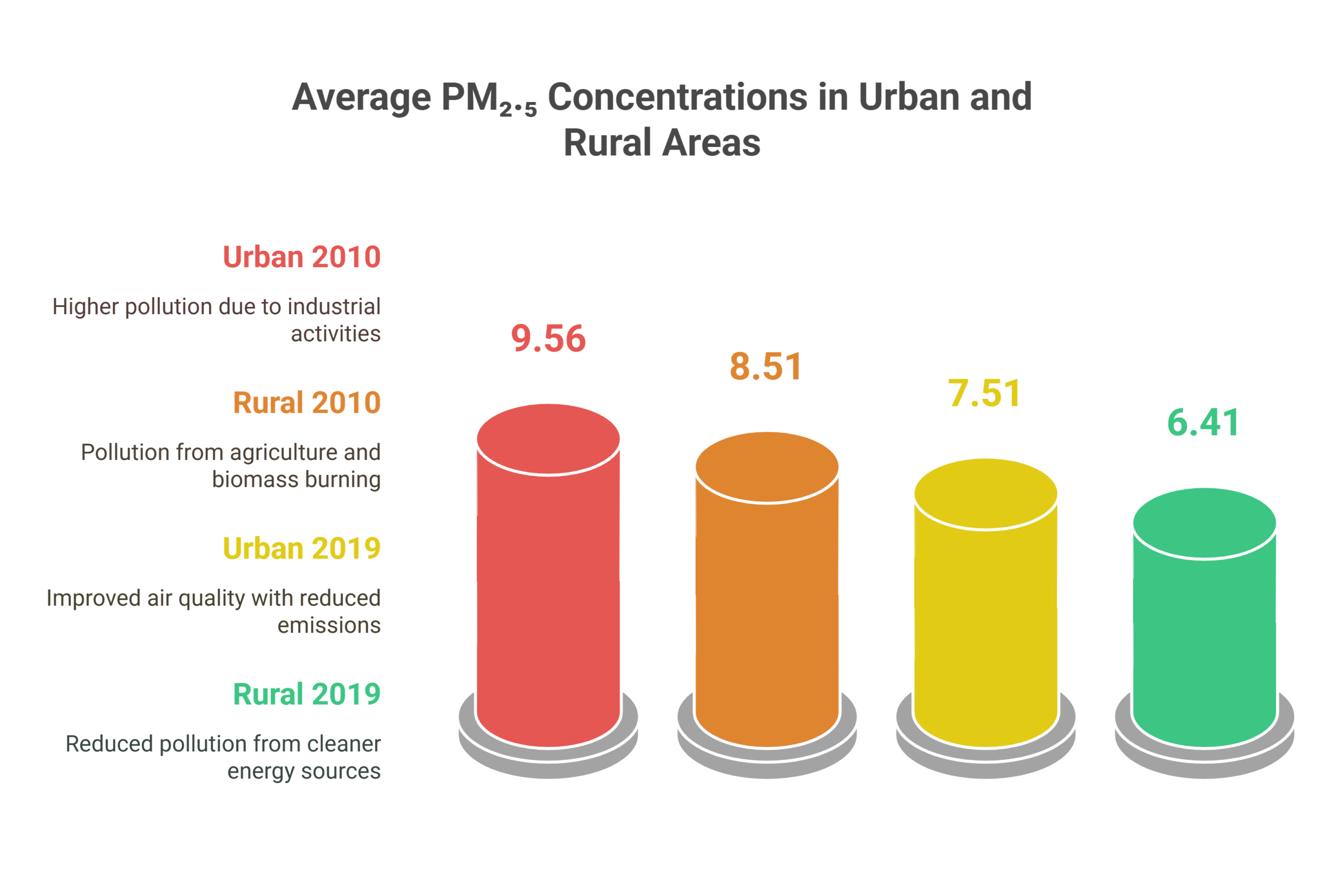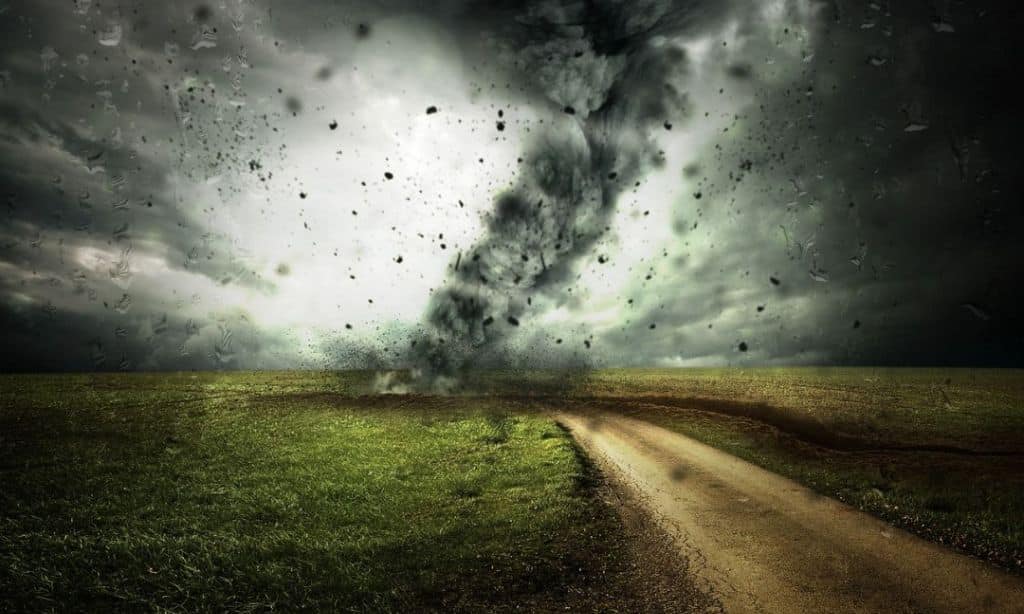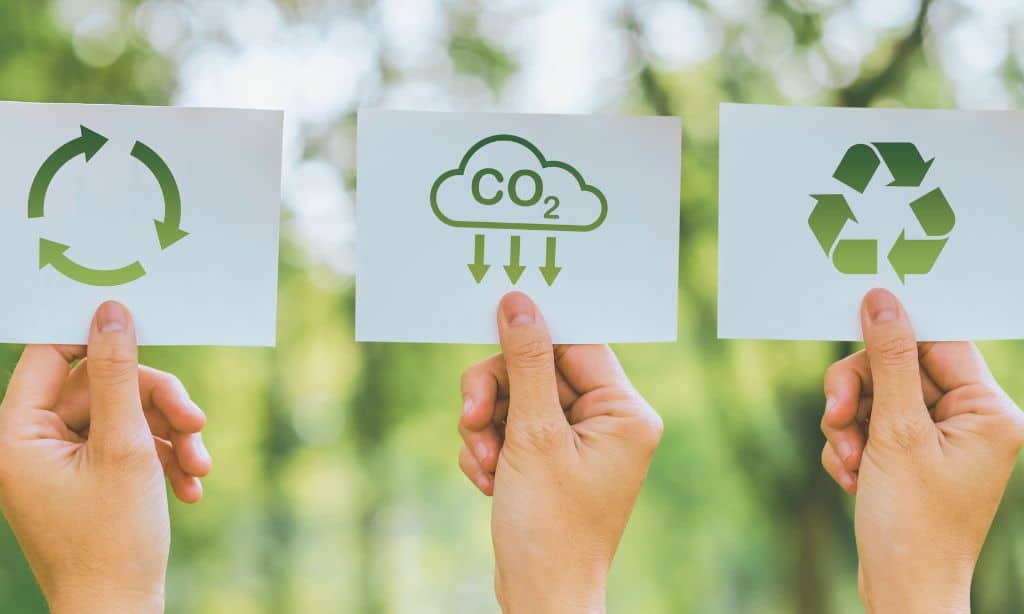Many people wonder about the effects of where they live on the environment. They ask, “how does urban living compare to rural living in terms of environmental impact?” This question is important for those trying to make eco-friendly choices.
One fact we know is that city life leads to lower per person use of resources like gas and water. This blog post will look at different aspects, such as air pollution and energy use, in both settings.
We aim to help you understand these impacts better. Keep reading to learn more!
Environmental Footprint: Urban vs. Rural
People in cities and the countryside live differently. This changes their impact on the world around them.
Carbon emissions per capita in urban and rural settings
Rural residents often have a bigger carbon footprint than those living in cities. For example, in the U.S., each person emits 15.7 tonnes of carbon. This number is lower in China and the U.K., with 7.7 and 5.7 tonnes respectively.
Cities are getting better at cutting down carbon emissions by moving factories to rural areas. They also create jobs that focus on skills and services, helping them reduce their environmental impact faster.
Energy consumption patterns and efficiency differences
Moving from how cars and trucks fill the air with gases, we see homes do too but in different ways. City folks use less power than country dwellers. In numbers, that’s 85.3 million Btu versus 95 million Btu each year.
Yet, city people spend less money for this energy.
This shows us something important. Living close together in cities can make using power more smart and careful. It helps save not just money but also our planet. We learn that being near each other makes it easier to share and use things without wasting as much.
Land Use and Habitat Disruption
Cities grow, and with them, the concrete spreads—eating into forests and fields. This growth disrupts animal homes and plants, causing more than just a little trouble for nature’s balance.
Urban sprawl and its impact on natural ecosystems
Cities grow, and as they do, they spread out into the countryside. This spreading out is called urban sprawl. It causes problems for plants and animals. Their homes get taken over by buildings and roads.
Cars from the sprawl use more gas, which is bad for air quality.
In China, a study found something interesting about urban sprawl. At first, when cities start to expand, pollution goes down. But if they keep growing too much, pollution starts to go up again.
People have ideas on how to fix this. They suggest planning city growth carefully and setting limits on how far they can spread.
Agricultural land use in rural areas and biodiversity effects
Farming in rural areas changes the land and hurts wildlife. This kind of farming can make more pollution and harm the environment. It also breaks up natural places, which is bad for animals and plants.
We need to use the land in better ways that don’t hurt so much.
Better farming methods can help keep water clean and air fresh. These good steps are key for making sure farms don’t harm nature too much. Next, we look at how cities and the countryside handle trash differently.
Pollution Levels in Urban and Rural Areas
Cities often face worse air quality than the countryside. Farms might harm water more, thanks to chemicals and waste.
Air quality differences
Air quality in big cities is worse than in the countryside. Cities have more ozone days, up to 47.54, while noncore counties only have about 3.81. Particles like PM2.5 are also higher in cities, with 11.21 days compared to just 0.95 in less populated areas.
This means people breathe cleaner air outside of urban centers.
Levels of PM2.5 show a clear difference too; they drop from 11.15 μg/m3 in metropolitan areas to 8.87 μg/m3 where fewer people live. This decrease helps everyone enjoy better health and a safer environment away from city pollution.
Water pollution from urban runoff vs. rural agricultural practices
Cities create lots of water pollution. Rain washes pollution from streets into rivers. This includes oil, trash, and chemicals. Farms also pollute water but in a different way. They use fertilizers and pesticides that can get into the water.
Both city runoff and farm practices harm our waters.
Urban areas have hard surfaces that don’t let rain soak into the ground. Instead, this rain picks up pollutants and carries them to water bodies. Rural farming releases harmful substances like nitrogen and phosphorus into the water.
These come from using too much fertilizer or manure on crops. Each type of pollution affects fish, plants, and drinking water sources differently.
Waste Management Comparisons
Cities have big systems for getting rid of trash, using landfills and recycling. Country areas might not have these big systems and often burn trash or use smaller landfills.
Urban waste infrastructure vs. rural disposal methods
Urban areas often have advanced waste management systems. These include automated vacuum collection for trash. This tech helps keep cities clean. In rural areas, it’s harder to handle trash because homes are far apart and far from transfer stations.
To fix this, rural places sometimes work together. They make fewer but bigger transfer stations. This way, people don’t have to travel as much to throw away trash.
Transportation and Mobility
In cities, people often take buses or subways instead of driving. In the countryside, they usually need cars to go anywhere. This makes a big difference in how much pollution we make and how we use energy.
Want to learn more? Keep reading!
Dependence on automobiles in rural areas
People in rural areas rely a lot on cars. This is because they have fewer buses and trains. Cars take them to work, shops, and everywhere else they need to go. This choice makes their carbon footprints bigger.
Having to use cars all the time also means these places don’t do as well with green travel options. They could benefit from more renewable energy sources for transportation. But right now, cars are what they depend on every day.
Public transportation and walkability in urban areas
Cities offer buses, subways, and trains that make getting around easy without a car. These options are good for the air and cut down on the use of gas. They also help in making cities less crowded with cars.
Walking or biking in the city is another way to get places while keeping healthy. This helps lower risks of heart disease and other sicknesses.
Having these choices means people can save money on gas and car care. It also makes cities nicer places to live by reducing noise from cars and cleaning the air. Public transportation systems like buses and subways play a big part in cutting down pollution from cars.
This makes urban living better for our planet compared to places where you always need to drive.
Resource Consumption
In cities, people use less space and share resources, making things like heating more efficient. In the countryside, folks might rely more on wood for heat or grow their own food. Yet both face challenges in using energy wisely and reducing waste.
Dig into this to learn how we can all live better with nature.
Urban density and utility efficiency
Cities with lots of people use less energy per person. This happens because buildings are closer together. It’s easy to heat or cool many homes at once. Public transport also helps make energy use lower.
People live near where they work and shop, so they don’t need to drive as much.
Using a mix of power sources is better in these busy places too. They rely on solar panels, wind turbines, and other clean ways to make electricity. This cuts down on harmful gases going into the air.
Plus, city folks often recycle more and waste less water, making cities a bit greener.
Rural reliance on natural resources
Shifting from urban efficiency, rural areas have a unique relationship with nature. They depend on natural resources more directly. Rural folks use land for farming and wood from forests for heat and building.
This close tie to the earth has costs and benefits. On one hand, it means cleaner air and water in these areas. On the other, managing waste can be hard without city systems.
Rural living also taps into non-renewable resources like coal for power generation. Energy comes from burning fossil fuels or using biofuels made from crops. Cars are needed more because things are far apart, which increases carbon emissions.
Even though people in rural places use less energy overall, their choices can still impact the environment greatly.
Climate Resilience and Adaptation
Cities get very hot, creating what we call “urban heat islands.” This means they have to find new ways to cool down and deal with the weather getting hotter. In the countryside, people who farm might have a hard time when weather patterns change, affecting their crops.
Both places need smart plans to handle these challenges—like building greener spaces in cities or changing what farmers grow. Learn more about how both urban and rural areas are finding ways to stay strong against changing climates.
Urban heat islands and their environmental challenges
Urban heat islands make cities hotter. They can raise temps by 1°F to 7°F during the day. At night, it’s even warmer by 2°F to 5°F compared to the countryside. This happens because cities have lots of buildings and roads.
These surfaces don’t cool down fast. They store heat.
To fix this, there are ways like adding more green spaces or using shiny materials on roofs and pavements. Plants help cool areas down. Shiny surfaces reflect sunlight away. Also, places where unfair housing rules used to be are often hotter by about 2.6°C than others without these old rules.
So, planting trees in these neighborhoods helps a lot too.
Rural vulnerability to changing agricultural conditions
Climate change hits rural areas hard. These communities face big risks from the weather. When it gets too hot, cold, or stormy, farms suffer. Crops can fail. This means less food and more problems for everyone living there.
Government help is key to making these areas stronger against climate shifts.
These actions might include teaching farmers about sustainable practices or giving them tools to adapt—like seeds that can grow in harsher conditions. It’s all about making sure people in rural spots can keep farming and living well, even when the weather changes a lot.
Next up, let’s talk about how cities and countryside areas are finding new ways to be kinder to our planet.
Social and Economic Factors Influencing Impact
Social and economic factors play a big role in how people affect the environment. In cities, folks have better access to new tech that helps keep the earth clean. But in the countryside, they often stick to old ways that may not be as kind to our planet.
Want to learn more? Keep reading!
Urban access to sustainable technologies
Cities offer more chances for using clean technology. People in cities see air pollution up close. This makes them want to try sustainable living options more. Cities have lots of innovations made just for them.
These include things like energy-efficient buildings and electric cars.
In cities, marketing strategies need to match what city folks are looking for. They care about reducing their environmental footprints. So, ads show how these technologies make life better while also helping the planet.
Next, we explore rural reliance on traditional practices.
Rural reliance on traditional practices
Shifting from urban sustainable technologies, we find rural areas have their own green methods. Rural folks often lean on old ways of doing things. This means they use what’s around them wisely.
They rely on the land, water, and plants nearby to live and work. These traditions help keep nature happy and healthy.
For example, farming without chemicals protects the soil and water. Growing local foods cuts down on waste and pollution from moving goods far distances. By sticking to these habits, rural communities can lower their harm to earth a lot.
Plus, using sunlight or wind for power fits right into these practices too. It shows that old ways can lead us to a cleaner future.
Potential for Sustainable Development in Urban and Rural Areas
Urban areas are turning to rooftop gardens and smart energy systems, while rural regions embrace wind farms and solar panels. This makes both settings ripe for sustainable growth. Dive in to learn more!
Urban innovations in green infrastructure
Cities are getting smarter about green spaces. They use rooftop gardens and rainwater harvesting to make places cooler and cleaner. This is a big step for urban sustainability. It helps with air quality too, making city life better for everyone.
Green tunnels and walls of plants are popping up in cities. These not only look good but also help fight the heat island effect where cities get too hot. Plus, they support local wildlife and cut down on noise pollution.
By focusing on these innovations, cities can grow in ways that are good for the planet.
Rural opportunities for renewable energy adoption
Moving from urban green projects, the countryside also holds big chances for using more earth-friendly energy. Many country homes already use power from the sun and wind. This is a step towards cleaner living.
The air and water in these places are cleaner too. This makes it easier to use renewable sources.
Putting up solar panels or windmills in rural areas can really help the planet. It uses less coal, oil, or natural gas which dirties the air. People living there can produce their own electricity this way.
They don’t have to rely on bringing in power from far away places. Plus, using sunlight and wind for energy does not pollute.
Takeaways
Urban living and rural life affect the Earth differently. Cities use resources smarter but make more waste. In contrast, country areas need more stuff per person but harm less land.
Both places can be better for the planet if they try new green methods. Think about how you live – could you change to help? Everyone’s choices matter for a healthier world.
References
- https://climateadaptationplatform.com/who-has-the-bigger-carbon-footprint-rural-or-urban-dwellers/
- https://www.nature.com/articles/s42949-023-00084-2
- https://www.treehugger.com/urban-or-rural-which-is-more-energy-efficient-4863586
- https://www.researchgate.net/publication/227439309_A_Carbon_Consumption_Comparison_of_Rural_and_Urban_Lifestyles (2024-10-22)
- https://pmc.ncbi.nlm.nih.gov/articles/PMC8391967/
- https://www.mdpi.com/2073-445X/13/3/303
- https://pubmed.ncbi.nlm.nih.gov/28640797/
- https://www.sciencedirect.com/science/article/pii/S0048969719361212
- https://www.freedrinkingwater.com/blogs/water-quality/j-2-08-differences-in-rural-urban-water-quality
- https://choosetiger.com/waste-management-in-urban-vs-rural-areas-challenges-and-solutions/ (2024-07-11)
- https://brainly.com/question/19383607 (2020-11-19)
- https://www.frontiersin.org/journals/built-environment/articles/10.3389/fbuil.2021.721218/full
- https://bmcpublichealth.biomedcentral.com/articles/10.1186/s12889-023-15394-4
- https://pmc.ncbi.nlm.nih.gov/articles/PMC9333300/
- https://www.rff.org/publications/explainers/urban-heat-islands-101/ (2023-03-14)
- https://www.researchgate.net/publication/320368218_Coping_with_the_impacts_of_Urban_Heat_Islands_A_literature_based_study_on_understanding_urban_heat_vulnerability_and_the_need_for_resilience_in_cities_in_a_global_climate_change_context (2024-10-22)
- https://www.mdpi.com/2673-8392/3/2/52
- https://www.sciencedirect.com/science/article/pii/S074301672300058X
- https://www.frontiersin.org/journals/sustainability/articles/10.3389/frsus.2021.670866/full
- https://pmc.ncbi.nlm.nih.gov/articles/PMC9747644/
- https://www.sciencedirect.com/science/article/pii/S0048969720351184
- https://www.researchgate.net/publication/245409093_Can_green_infrastructure_promote_urban_sustainability (2024-10-22)
- https://brainly.com/question/42511141 (2023-11-12)






































